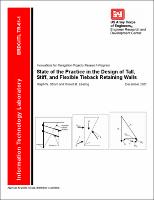Please use this identifier to cite or link to this item:
https://hdl.handle.net/11681/10876| Title: | State of the practice in the design of tall, stiff, and flexible tieback retaining walls |
| Authors: | Innovations for Navigation Projects Research Program (U.S.) Strom, Ralph W. Ebeling, Robert M., 1954- |
| Keywords: | Allowable stress design Anchored wall Ground anchor Retaining wall Soldier beam Tieback wall Bulkheads Design |
| Publisher: | Information Technology Laboratory (U.S.) Engineer Research and Development Center (U.S.) |
| Description: | Technical Report Abstract: In tieback wall design, the determination of anchor loads and wall forces requires knowledge about the interaction between the wall and the soil during successive stages of excavation, as well as after completion of the project. Interaction between the wall and soil is difficult to predict. As a result, simple methods of analysis have been developed for use in the design of various tieback wall systems. These methods may, or may not, require a construction sequencing analysis. This report describes state-of-the-practice analytical methods used to evaluate tieback wall performance and to design the tieback wall and ground anchor system. Analytical methods include equivalent beam on rigid support methods, beam on elastic foundation methods, and finite element methods. The applicability of the various design methods with respect to various tieback wall systems frequently used on Corps projects is described in the report. Tieback wall systems covered in the report include vertical sheet-pile systems, soldier beam systems with wood or concrete lagging, secant cylinder pile systems, reinforced concrete slurry wall systems, and slurry wall systems constructed using soldier beams and concrete lagging. Analysis methods depend on whether the tieback wall system is stiff or flexible. The report describes the characteristics of stiff and flexible tieback wall systems and indicates how the analysis method selected can be influenced by wall stiffness. |
| Rights: | Approved for public release; distribution is unlimited. |
| URI: | http://hdl.handle.net/11681/10876 |
| Appears in Collections: | Technical Report |
Files in This Item:
| File | Description | Size | Format | |
|---|---|---|---|---|
| ITL-TR-01-1.pdf | 7.76 MB | Adobe PDF |  View/Open |